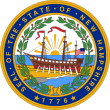Governor of New Hampshire facts for kids
Quick facts for kids Governor of New Hampshire |
|
|---|---|

State seal
|
|
| Government of New Hampshire | |
| Style |
|
| Member of | Governor's Council Cabinet |
| Residence | Bridges House |
| Seat | Concord, New Hampshire |
| Term length | Two years, no term limits |
| Constituting instrument | New Hampshire Constitution of 1776 |
| Precursor |
|
| Formation | January 21, 1680 |
| Succession | Line of succession |
| Salary | $146,172 |
The Governor of New Hampshire is the main leader of the U.S. state of New Hampshire. This person is like the chief executive, making sure the state runs smoothly.
The governor is chosen by voters every two years in November. New Hampshire is special because it's one of only two states (the other being Vermont) where governors are elected every two years, not every four. As of January 9, 2025, the current governor is Kelly Ayotte, who is a Republican. She is the 83rd governor of the state.
In New Hampshire, there's no limit to how many times a person can be elected governor. Some governors have served for a long time! For example, John Lynch and Chris Sununu both served four two-year terms. Before them, John Taylor Gilman served 14 one-year terms between 1794 and 1816.
Unlike many other states, New Hampshire has an Executive Council of New Hampshire. This council has five members and a lot of power. They can even say no to many of the governor's plans. Together, the governor and the council approve important contracts, grant pardons (forgiveness for crimes), and choose many state officials. These officials include judges, the attorney general, and leaders in the National Guard.
To become governor, a person must be at least 30 years old. They also need to be a registered voter and have lived in New Hampshire for at least seven years.
Contents
History of the Governor's Title
In the past, the leaders of the colonial Province of New Hampshire were called "President of New Hampshire." This started in 1679 with the first president, John Cutt. After New Hampshire became independent, the official title was "President of the State of New Hampshire" from 1786 to 1791. In 1791, the New Hampshire Constitution was changed. That's when the title "President" was officially replaced with "Governor."
What the Governor Does
The Constitution of New Hampshire explains the governor's important jobs and powers:
- The governor is the top executive leader of the state.
- They must make sure that all state laws are followed.
- If the two parts of the state legislature (the General Court) disagree, the governor can pause or end their session with advice from the Executive Council.
- The governor can move a meeting of the General Court to a different place in the state if there's a danger to people's health or safety.
- The governor can say no (veto) to bills and decisions passed by the General Court.
- They choose all judges, the attorney general, and military officers, but the Executive Council must approve these choices.
- The governor is the commander-in-chief of all the state's military forces.
- They have the power to pardon people who have committed offenses, except for those found guilty by the Senate after being accused by the House.
- Money from the state treasury can only be spent with the governor's approval and the council's advice.
Who Takes Over if the Governor Can't Serve?
If the governor cannot do their job, there's a clear plan for who takes over. This plan is set out in the Constitution of New Hampshire.
| # | Office | Current officer |
|---|---|---|
| 1 | President of the Senate | Sharon Carson (R) |
| 2 | Speaker of the House of Representatives | Sherman Packard (R) |
| 3 | Secretary of State | David Scanlan (R) |
| 4 | State Treasurer | Monica Mezzapelle (D) |
Timeline of New Hampshire Governors
This timeline shows when different people served as governor of New Hampshire.
| Timeline of New Hampshire governors |
 |


